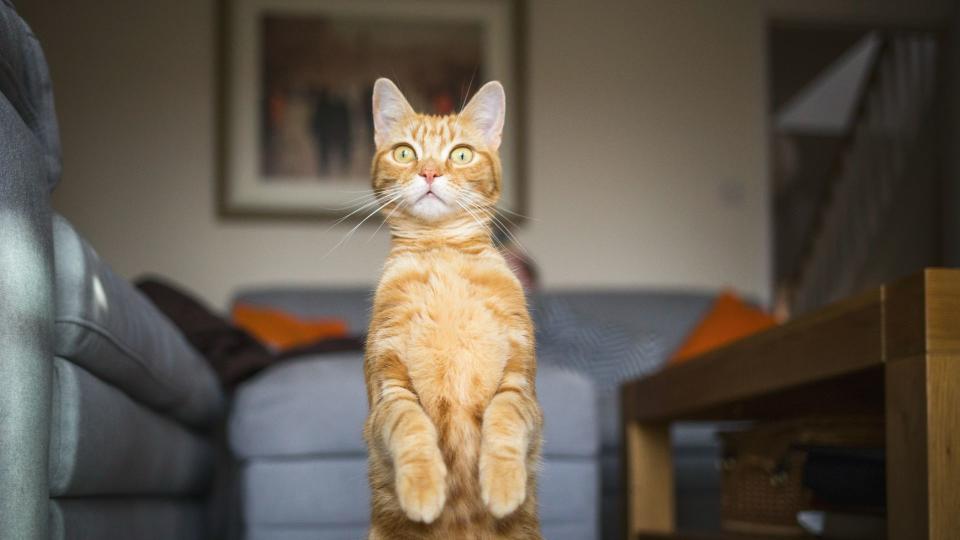32 tips for training your cat

When you think of training, cats may not be the first animal you think of. But cats can benefit from solid training just as much as dogs can.
If you have a cat or new kitten you may have wondered can you train a cat or what is the point of cat training, they look perfectly happy taking a nap by the window or climbing up the best cat tree. But the truth is cats and kittens need the mental stimulation and physical activity from training. This can help curb some unwanted behaviors such as scratching or biting, help them sleep better, and the main one use the bathroom in their litter box.
If you're feeling overwhelmed with where to begin, don't worry we've compiled our top tips for training your cat.
32 tips for training your cat
1. Decide on a goal

Decide on a goal and be realistic. Maybe you want to tackle potty training, or teaching your cat to sit. Whatever it might be make a goal to give yourself and your cat something to work towards.
2. Be patient

Training a new skill takes time and effort. Be patient with your kitty, they will probably not get it on the first try and that's okay. Keep at it and before you know it, your cat will have it down.
Also, be patient with yourself, training takes a lot of mental energy from both you and your cat, so be sure to give yourself some grace.
3. Be consistent

Whether you are using verbal cues or a hand gesture, be consistent in what you are doing. If you constantly change what you're doing to teach a skill it will be harder for your kitty to catch on.
4. Stick to a routine

You could give your kitty breakfast, play for a while, and then work on skill. Or maybe you decide to do some training before dinner each day. Having a similar rhythm to your day can help your cat feel comfortable and secure and be more likely to want to participate in a training session with you.
5. Equipment

You will want to make sure you are ready and stocked with the essentials. You definitely need things like the best cat treats to reward your cat, the best cat harness if you are working on leash training, and even some of the best kitten toys if your feline prefers playtime over treats.
6. Get the entire family on board

If you are going to be training in a house with other family members you'll want to ensure that everyone is on the same page. If one person allows your kitty to stand on the counter and you don't, this will send mixed messages to your feline.
7. Start small

You may want to start with commands like, coming when called or sitting. Whichever trick you'd like to work on, we recommend starting with an easy one and then building from there.
8. Keep training sessions short

Nobody wants to sit in an hour-long training session. This can end in both you and your cat feeling frustrated and tired. Keep training sessions short, even just a couple of minutes will be plenty. This will keep your kitty's attention and they will be more likely to want to do more training with you.
9. Positive reinforcement

Positive reinforcement is the best way to support your kitty during training. Even older cats will benefit from the use of positive reinforcement when they do something that you would like them to keep doing. This can be done in the form of treats, or even redirection. If your cat is scratching the couch, for example, move them to one of the best cat scratching posts to show where they can scratch.
10. Do not punish bad behavior

We never recommend the use of shouting, spraying, or being rough with your cat. While it may seem that it stops the behavior at the moment, it is unlikely to teach your cat the correct behavior, or what they can do instead. It can also lead to anxiety in cats and them feeling unsafe around you.
11. Eliminate distractions

It can be hard for anyone to focus when the t.v. is blasting, or there are a lot of people around talking to you. This can be distracting for your cat as well. Try to offer sessions in a quiet area, maybe in their own space in the house or somewhere with minimal distractions.
12. Pick the best time of day

Just like humans, a cat's energy levels can ebb and flow over a 24 hour period. If you notice your cat's mood is the best in the morning, try a training session then. Or maybe your cat is more likely to engage in the evening, give that a try.
13. Reward immediately

According to the Humane Society of the United States, you should offer a reward within seconds of your pet doing the desired task. If offered too late, your pet may not associate it with the skill you are working on.
14. Decide which tricks to start with

This can be done in the goal-setting process, but deciding ahead of time which tricks and skills you want to start with can help you and your kitty stay on track. Once your cat has mastered these skills you can work on more complex ones.
15. Find your cat's love language

Some kitties will be motivated with treats, others may want all the snuggles, and some may crave some one-on-one time with their pet parents. For these cats, knowing how to play with a cat is crucial.
16. Wait for the right time

If your kitty or cat has just had shots or surgery of some kind, this will not be the right time for training. Likewise, if life is super busy for you, wait until things quiet down. A calm home life will support your cat while they are tackling new skills.
17. Does not have be a trick

When you think of training you may think of the common skills like sitting, giving their paw, or even jumping. But training can also help with things that they feel anxious or scared of. This could include, traveling in their carrier (even if it is one of the best cat carriers), or getting their ears checked at the vet. You can help them associate these things with something positive, like getting a treat or plenty of snuggles with you.
18. Focus on one skill at a time

You don't want to overwhelm your kitty with learning a ton of new skills at once. Focus on one skill and then once your cat has that one down, move on to the next one.
19. Choose a training method

Is clicker training recommended for cats? We think so, in addition to clicker training, you can use hand signals or verbal cues to train your cat. Whichever you choose, make sure you stick to it so you don't confuse your furry feline.
20. Know you cat's body language beforehand

Knowing the signs of a happy cat will be very important while learning new skills. Pay attention to how your cat behaves when they are happy and content. Just as importantly notice how they act when they are anxious or stressed. If you notice any signs that your cat has had enough, end your training session.
21. Get extra support

Do not be afraid to ask for help. This doesn't mean you aren't doing a great job or that you have failed. Training a new skill is no easy feat and having the extra help can sometimes make all the difference. Reach out to your vet, or a cat behaviorist. Sometimes local shelters can offer resources to support you.
22. Reward natural behavior

If you are working on potty training for example, and you see your cat go use the bathroom in the litter box unprompted, make a big deal! We want them to know that this is the behavior we want to see even when we are not actively working on it.
23. Try out a different heights

If your cat is sitting on the floor and you are standing, it may seem like you are looming over them and we don't know about you but that wouldn't help us feel good about learning something new. You can try sitting next to your cat, or place them on one of their cat towers.
24. Train when your cat is calm and happy

This fits along with training at the best time of day for your kitty. But if you notice your cat seems a little grumpy or just not in the mood for playing around skip the training session and try again at a different time. You don't want your cat to associate learning new things with stress.
25. Watch out for signs they are losing interest

If your cat is starting to lose interest, it is best to end the session. Cats can sometimes be aloof and easily distracted, if it feels like you are working harder than your cat during a training session then go ahead and call it quits for the day. You can always come back when your cat is fresh and ready to learn.
26. Don't force a session

Just to reiterate, do not force a training session. If your cat feels like they are being forced or pressured they are less likely to want to cooperate. Training sessions should be easy breezy and stress-free.
27. Train before mealtimes

If your cat is a foodie and you are using treats as a reward, try to avoid training right after mealtimes. If your cat is already full, they are less likely to be interested in treats.
28. Litter training still counts as training

Knowing how to get a cat to use a litter box is not something that you will just know. Especially if you have a kitten, they will need to be taught to go to the bathroom in the best cat litter box. So while this may not be as fun as tricks like, sitting or coming when cold, litter training still counts as training and should be worked on solely without teaching other skills at the same time.
29. Set up self-care

This tip is for you. While having a pet can lower your stress levels, teaching your cat a new skill can raise them right back up. Make sure you are taking care of yourself as well during this time. Schedule some self-care whether that be in the form of reading a new book, taking a walk, or whatever feels best to you. When you are at your best, you can show up for your cat in the best way.
30. Hide the treats

If you are using treats keep them hidden while training. If your cat sees them they may be too focused on getting to the food than working on their trick.
31. Start young

While it is definitely possible to retrain a cat to use the litter box, the earlier you start the easier it will be. Similarly, if you start from early on and stay consistent with your cat, it will help them adjust easier to their surrounding.
32. Consider using human food as treats

Some cats are not in love with cat treats and are more interested in the foods that their humans are eating. While there are certainly foods that cats should never eat there are some that are safe and tasty for cats. Foods like cooked chicken or sweet potato are just a few DIY cat treats you can whip up in under 30 minutes.
